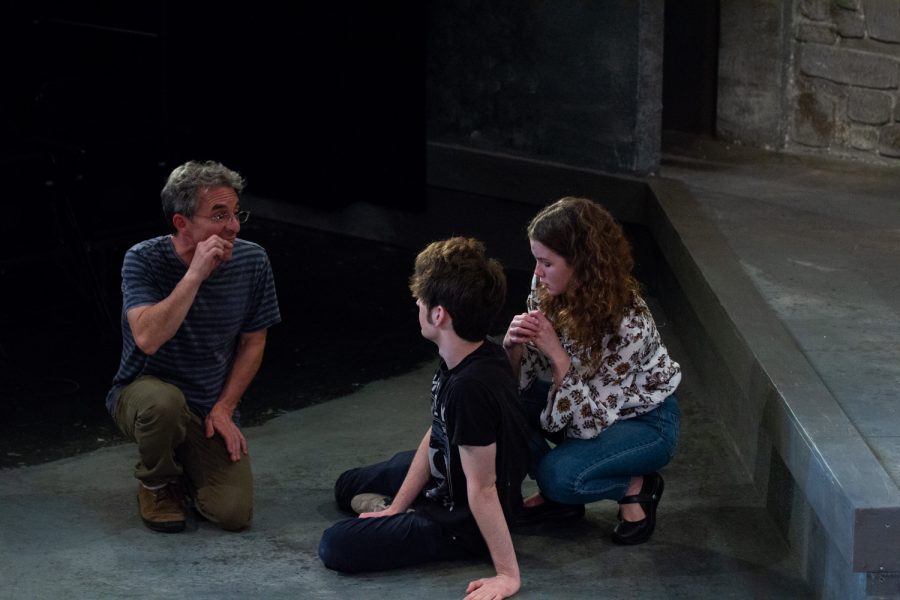
“The Oresteia” is a difficult play, not one to treat lightly. It is a complex play in its poetic literacy, story and social complications. The famous Greek trilogy-tragedy by Aeschylus follows the murder of Agamemnon by his wife Clytemnestra, her subsequent murder by her son Orestes (after whom the trilogy is named), and his trial. The original play is packed with murder, psychological torture, gender roles, personal vendetta and divine fatalism. It is a daunting task to direct in a compelling way for a modern audience.
So even though I’m a tremendous lover of Whitman theater, I was a little skeptical. The play had not one but three student directors and budget of no more than $200. Oh, and it’s a Greek tragedy, and no one really likes watching those anymore, right? So, while I hoped for the best, I was fairly prepared for a moderately blasé production.
Of course watching the show fairly well trounced these expectations.
The directors, juniors Zach Simonson, Erin Terrall and Devin Petersen, directed one part of the trilogy each: “Agamemnon,” “The Libation Bearers” and “The Eumenides” respectively. Despite my qualms, their styles of directing flowed together surprisingly well.
Simonson’s direction was less stylized than Terrall’s and Petersen’s, reflecting traditional Greek theater more closely. He focused more upon individual voicing and character interaction.
Terrall featured active character movement, dramatic lighting and an artistic (though moderately gruesome) Clytemnestra death scene, in which she has her throat “cut” without Tarantino-esque special affects.
Petersen produced quite terrifying images of bloody, hissing Furies, accompanied by otherworldly screaming noises over the sound system.
The acting, despite the rushed few-week production, was overall quite strong. Most of the actors made bold choices, some even taking on several different roles throughout the performances. Sophomore Tricia Vanderbilt, who played the role of the Nurse in “The Libation Bearers” and Athena in “Eumenides,” showcased tremendous acting talent in both roles. Even without the use of prosthetics or a few drawn-on wrinkles, she groaned and bent sadly as the tired and grieved Nurse and then glowed with wisdom and stoicism as the levelheaded goddess
Other outstanding roles included ’09 alumnus Bryce McKay as the protective Apollo, junior Anastasia Higham as the maddened Cassandra and one of the bloodthirsty Furies and junior Trevor Cushman as the political figure Agamemnon.
One aspect of the show that intrigued me was the set. Modest and small, it included black stage curtains, a small raised level with a black top, a gold door lined in red and the imposing black of the Friemann stage. Perhaps it was because of the simplicity, but it was very striking, authentic and coordinating with the overall mood. I was particularly pleased when the platform opened between “Agamemnon” and “The Libation Bearers” to reveal a small, lit pool marking Agamemnon’s grave and the site of Clytemnestra’s murder: an equally striking addition.
My only valid complaint about the play was the lack of focus on the gender discrepancies that so dominate the story. Well-known for its overwhelming sympathy towards the male characters, I was hoping to find a slightly more compelling Clytemnestra. The queen, while unfaithful and murderous, does have her reasons of acting so: Agamemnon, who leaves her for over a decade, sacrificed her favorite daughter and replaced her position as wife with his new concubine Cassandra. However, Clytemnestra came across as fairly evil, bloodthirsty and politically motivated in this production. But perhaps that is just my gender studies class speaking to me.
Despite the slight discrepancy in style, the overall arch was quite satisfying. Hopefully, since the turnout for each show was very good, more small student productions of this magnitude and caliber will be available in the future.









